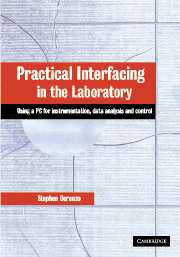Book contents
- Frontmatter
- Contents
- Preface
- Acknowledgments
- 1 Digital tools
- 2 Analog tools
- 3 Analog ↔ digital conversion and sampling
- 4 Sensors and actuators
- 5 Data analysis and control
- Appendix A Grounding and shielding
- Appendix B Experimental uncertainties
- Appendix C C programming tips
- Appendix D Numerical methods and C functions
- Appendix E Summary of Data Translation DT3010 PCI plug-in card
- Appendix F Using the digital oscilloscope to record waveforms
- Appendix G Electrical hazards and safety
- Appendix H Standard resistor and capacitor values
- Appendix I ASCII character set codes
- Glossary
- Index
Appendix B - Experimental uncertainties
Published online by Cambridge University Press: 04 August 2010
- Frontmatter
- Contents
- Preface
- Acknowledgments
- 1 Digital tools
- 2 Analog tools
- 3 Analog ↔ digital conversion and sampling
- 4 Sensors and actuators
- 5 Data analysis and control
- Appendix A Grounding and shielding
- Appendix B Experimental uncertainties
- Appendix C C programming tips
- Appendix D Numerical methods and C functions
- Appendix E Summary of Data Translation DT3010 PCI plug-in card
- Appendix F Using the digital oscilloscope to record waveforms
- Appendix G Electrical hazards and safety
- Appendix H Standard resistor and capacitor values
- Appendix I ASCII character set codes
- Glossary
- Index
Summary
Multimeter accuracy
The following is the typical accuracy for a student-type digital multimeter, information often provided on the back of the meter. The shorthand notation (A + B) means that the uncertainty of the reading is guaranteed to be less than ±(A% of reading + B least significant digits):
Max counts 2,000 (e.g. 2.000 V or 200.0 mV or 2,000 ω)
<200 V dc (0.1 + 1) 45 Hz to 10 kHz (0.5 + 2)
<200 mA dc (0.3 + 1) 45 Hz to 10 kHz (1.0 + 2)
<200 kΩ (0.2 + 1)
>2 MΩ (0.5 + 1)
For example, for a reading of 1.453 V dc, the uncertainty is less than ±(1.453 × 0.1% + 0.0001) V. For a reading of 1.453 V ac, the uncertainty is less than ±(1.453 × 0.5% + 0.002) = ±0.009 V.
Note that in the latter case, the accuracy (adherence to the accepted standard) is ± 0.009 V, but the precision (ability to detect small changes) is one least significant digit, or ±0.001 V.
A triangular distribution with full width ±W has a standard deviation σ = 0.408W. So as a rule of thumb, the multimeter uncertainty can be thought of as representing approximately 2.5 standard deviations.
- Type
- Chapter
- Information
- Practical Interfacing in the LaboratoryUsing a PC for Instrumentation, Data Analysis and Control, pp. 508 - 509Publisher: Cambridge University PressPrint publication year: 2003
- 1
- Cited by



